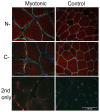A novel mutation in CLCN1 associated with feline myotonia congenita
- PMID: 25356766
- PMCID: PMC4214686
- DOI: 10.1371/journal.pone.0109926
A novel mutation in CLCN1 associated with feline myotonia congenita
Abstract
Myotonia congenita (MC) is a skeletal muscle channelopathy characterized by inability of the muscle to relax following voluntary contraction. Worldwide population prevalence in humans is 1:100,000. Studies in mice, dogs, humans and goats confirmed myotonia associated with functional defects in chloride channels and mutations in a skeletal muscle chloride channel (CLCN1). CLCN1 encodes for the most abundant chloride channel in the skeletal muscle cell membrane. Five random bred cats from Winnipeg, Canada with MC were examined. All cats had a protruding tongue, limited range of jaw motion and drooling with prominent neck and proximal limb musculature. All cats had blepharospasm upon palpebral reflex testing and a short-strided gait. Electromyograms demonstrated myotonic discharges at a mean frequency of 300 Hz resembling the sound of a 'swarm of bees'. Muscle histopathology showed hypertrophy of all fiber types. Direct sequencing of CLCN1 revealed a mutation disrupting a donor splice site downstream of exon 16 in only the affected cats. In vitro translation of the mutated protein predicted a premature truncation and partial lack of the highly conserved CBS1 (cystathionine β-synthase) domain critical for ion transport activity and one dimerization domain pivotal in channel formation. Genetic screening of the Winnipeg random bred population of the cats' origin identified carriers of the mutation. A genetic test for population screening is now available and carrier cats from the feral population can be identified.
Conflict of interest statement
Figures








References
-
- Kimura J (2013) Electrodiagnosis in Diseases of Nerve and Muscle; Principles and Practice, Oxford University Press.
-
- Colding-Jorgensen E (2005) Phenotypic variability in myotonia congenita. Muscle Nerve 32: 19–34. - PubMed
-
- Lossin C, George AL (2008) Advances in Genetics. - PubMed
-
- Koch MC, Steinmeyer K, Lorenz C, Ricker K, Wolf F, et al. (1992) The skeletal muscle chloride channel in dominant and recessive human myotonia. Science 257: 797–800. - PubMed
Publication types
MeSH terms
Substances
Grants and funding
LinkOut - more resources
Full Text Sources
Other Literature Sources
Miscellaneous

